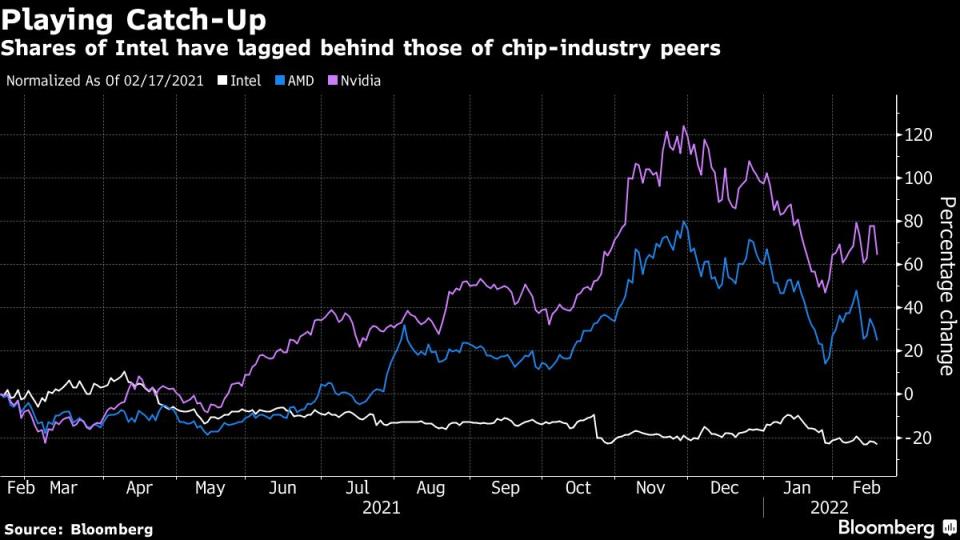Intel Sees Sales Picking Up in Coming Years as It Makes Comeback
(Bloomberg) -- Intel Corp. expects revenue to rise by just under 2% this year, with growth picking up in later years as Chief Executive Officer Pat Gelsinger pursues a turnaround of the once-dominant chipmaker.
Most Read from Bloomberg
Zelenskiy Urges Russia to Hold Off on Escalation: Ukraine Update
Blinken Says Meeting With Lavrov Is Canceled: Ukraine Update
Biden’s First Salvo of Russia Sanctions Hits With Thud, Not Roar
Leissner Says Lover Blackmailed Him Into Buying $10 Million Home
Goldman Sachs Wants Its Bonuses Back as Punishment for Jumping Ship
Sales will amount to $76 billion in 2022, before climbing by a mid- to high-single-digit percentage by 2023 and 2024, the company said at an investor event in San Francisco. Analysts have predicted growth of 1% this year, with sales ticking up 3% in 2023 and 8% in 2024.
Intel called for earnings of $3.50 a share in 2022, excluding some items. That too was slightly higher than the estimate of analysts, who have predicted $3.44. Wall Street’s sales projection was $75.1 billion.
“I feel confident in our plan to accelerate and deliver,” Gelsinger said at the event.
So far, Intel has struggled to capitalize on booming demand for chips -- a surge fueled by the work-from-home trend and the spread of semiconductors into a wider range of devices. While the chip industry’s sales gained 26% last year to a record total of $556 billion, Intel posted a 4% decline.
The company’s rivals, meanwhile, have been flourishing. Advanced Micro Devices Inc.’s sales grew 68% last year, and Nvidia Corp. posted a 61% gain. Those companies are on course to expand sales more than 25% again in 2022, according to analysts’ projections.
The biggest chunk of Intel’s sales still comes from the personal-computer market, where its processors remain the most important component of the majority of laptops and desktops. Last year, PC shipments climbed back to levels not seen for a decade, helped by the shift to remote work. But analysts have expressed concern over whether that will continue. And Intel is facing fiercer competition from AMD, and some customers -- like Apple Inc. -- are switching to their own chips.
Gelsinger took over the top spot at Intel a year ago, rejoining the chipmaker after about a decade’s absence. The company’s leading executives took to the stage Thursday to explain how they’ll restore Intel’s dominance in the semiconductor business.
Gelsinger, 60, outlined a plan to spend tens of billions on new factories that will put him in direct competition with outsourced manufacturing providers such as Taiwan Semiconductor Manufacturing Co. and Samsung Electronics Co. At the same time, he’s shaking up Intel’s internal production technology operations and is targeting a return to leadership by 2025. The company is also entering new markets such as graphics chips where it will go head to head with AMD and Nvidia.
Chief Financial Officer Dave Zinsner promised increased financial discipline as Intel tries to win back market share and enter new industries. After its spending on new plants peaks over the next two years, he expects gross margin -- the percentage of sales remaining after deducting the cost of production -- to be in the 54% to 58% range. That’s still below Intel’s historical highs of more than 60%, but the company’s push into outsourced chip production will weigh on margins, he said.
The company expects revenue growth to hit 10% to 12% by 2025 and 2026, when its “investment phase” is over.
Intel said that its graphics chip business could approach $10 billion by 2025. Its outsourced chip business, meanwhile, is still in the early stages -- “just beginning,” Gelsinger said. Intel announced the $5.4 billion acquisition of Tower Semiconductor Ltd. this week to help shore up those operations.
Investors have been skeptical. The company’s shares fell 23% in the past year, trailing most of their peers in the Philadelphia Stock Exchange Semiconductor Index. And the stock has declined sharply each time Intel has reported earnings -- a sign investors aren’t happy with the progress they’re seeing.
Against that backdrop, Gelsinger assured shareholders that his comeback is taking hold.
“The Intel turnaround train is leaving the station and I hope you all get on board,” he said.
(Updates with details of forecast starting in first paragraph.)
Most Read from Bloomberg Businessweek
A Pandemic Baby Bump Shines a Spotlight on the Nordic Welfare Model
Wall Street Is Buying Starter Homes to Quietly Become America’s Landlord
The Abortion Pill Is Safer Than Tylenol and Almost Impossible to Get
©2022 Bloomberg L.P.


